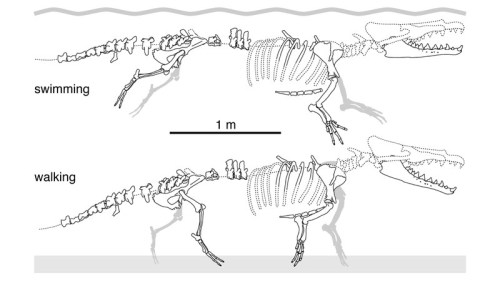
A lot of the popular reaction to new discovery of a 42.6-million-year-old amphibious whale in Peru has focused on the fact that this whale had four legs. Yeah, four-legged amphibious whales first appeared in South Asia 50 million years ago, with most famous one being Pakicetus.
However, this reaction to this new discovery merely tells me that most people are unaware of how much we know about whale evolution. Whales and dolphin, in case you didn’t know, are actually a subset of artiodactyls. Artiodactyla is the same order that includes pigs, sheep, antelope, giraffes, cattle, and camels, and when scientists began to classify whales and dolphins this way, some creationist wag posted a strawman that scientists believed that whales evolved from cows.
No. Whales and dolphins are actually derived an ancestor that was very close the common ancestor of hippopotamuses. The clade that includes hippos and whales and dolphins is called Whippomorpha. Literally, they just combined the word “whale” and “hippo” to create this name.
Hippos are actually much more closely related to whales and dolphins than they are to other artiodactyls, and because whales and dolphins are so well-nested in Artiodactyla, some experts now call the order Cetartiodactyla, combing the word “Cetacean” with the word “Artiodactyla.” I personally don’t do this because we could just as easily renamed Carnivora “Pinnipedavora” because phocid seals, otariid seals, and the walrus are all derived from caniform ancestors.
Whales and dolphins, though, are derived from land-based artiodactyls. They are not derived from cows or any ruminants, though. Ruminants are highly specialized plant-eating mammals, which have a multi-chambered stomach to deal with the hard cellulose and fiber of their diets.
50 million years ago, though, there were many omnivorous and carnivorous artiodactyls. Mesonychids, which were quite numerous millions of years before whales evolved, were essentially artiodactyl wolves that ran down their prey on hoofed feet. When I was first reading about whale evolution as a teenager, it was believed that whales derived from Mesonychids, but now we have a more complete view of their evolution.
Pakicetus first appeared in the fossil record of South Asia. It was a sort of a semi-aquatic artiodactyl wolf, which then gave rise to Ambulocetus, a sort of mammalian crocodile-like creature.
From South Asia, these primitive whales entered the sea, and over time, they evolved into more and more specialized animals.
Four-legged whales have been found North America and Africa, but there has long been a debate about how whales dispersed from South Asia into the oceans of the world.
The discovery of this new extinct whale species called Peregocetus pacificus in Peru suggests that South Asian amphibious whales entered the now defunct Tethys Sea (which included the Mediterranean but went much further east), swam down around the Atlantic Coast of Africa, crossed the narrow distance of the Atlantic to enter South America, and then colonized North America. This colonization took about 10 million years after the whales began to become creatures of the water.
So yeah, we know a lot more about whale evolution now because of this discovery, and now the public knows that four-legged whales really were a thing.



